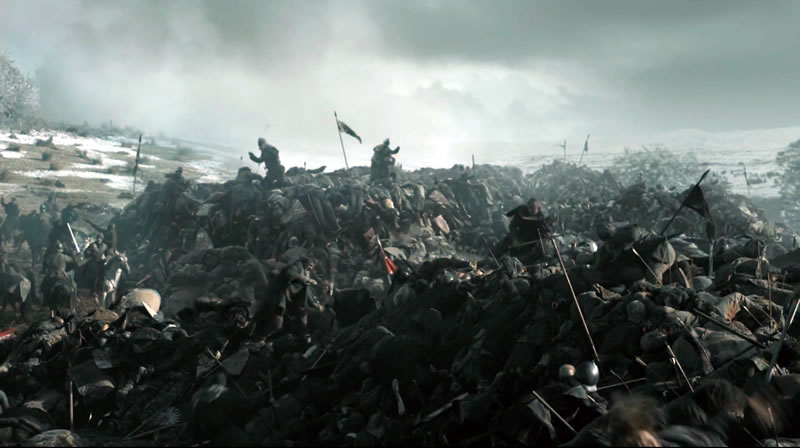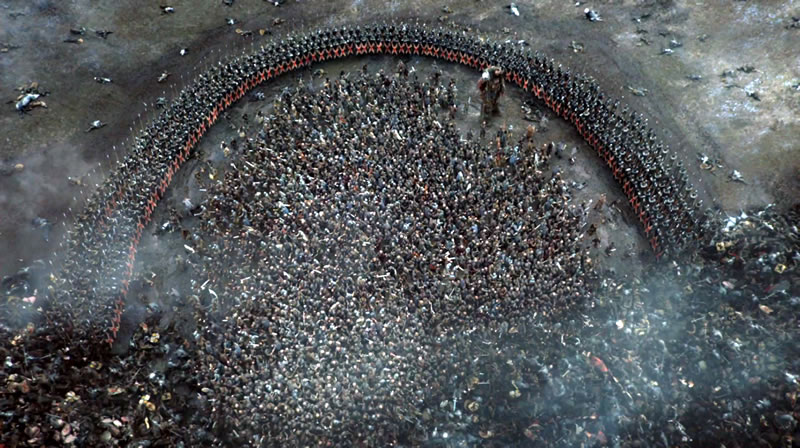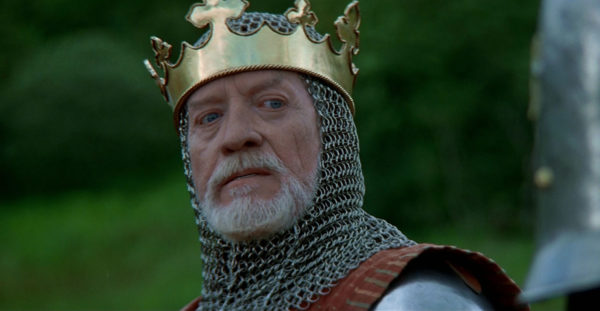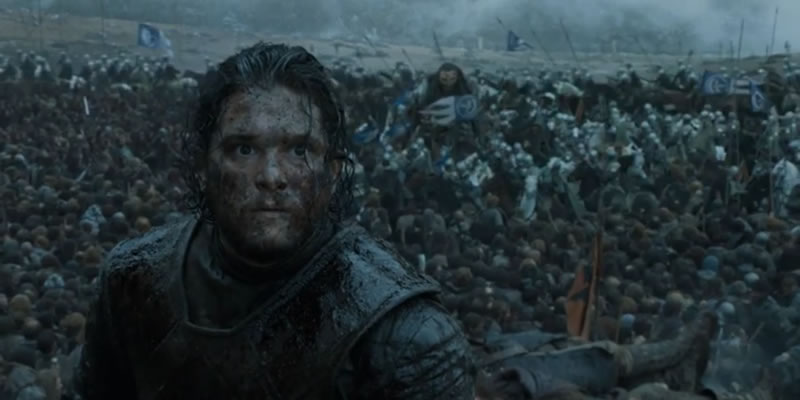The “Battle of the Bastards” episode of Game of Thrones has provided remarkable depictions of warfare that come straight from medieval chroniclers.
Here is a look at some of those depictions and their medieval equivalent.
SPOILER WARNING
The wall of the dead
One of the most striking features of the Battle of the Bastards is the wall of dead that piles up in the middle of the battlefield.

Ancient and medieval chroniclers describe them for numerous battles. For example, an English priest present at the Battle of Agincourt (1415) describes how
such a great heap grew of the slain and of those lying crushed in between that our men climbed up those heaps which had risen above a man’s height, and butchered their enemies down below with swords, axes, and other weapons. ((The Gesta Henrici Quinti (c. 1417), translation from Anne Curry, ed., The Battle of Agincourt: Sources and Interpretations (Woodbridge: The Boydell Press, 2009), 37.))
Other medieval chroniclers told similar stories from Agincourt. A French poem written shortly after the battle describes how “there in the dung, without a bed, were the dead sleeping, one on top of the other, in piles, heaps, some lying upwards, some face down.” ((Le pastoralet (c. 1422-25), translation from Anne Curry, ed., The Battle of Agincourt: Sources and Interpretations (Woodbridge: The Boydell Press, 2009), 352.)) Lying upward would require quite the pile.
Similarly, an English chronicle described how the English made the French knights “fall over, each on top of the other so that they lay in heaps two spear’s length in height,” ((The Brut (1436-1437), translation from Anne Curry, ed., The Battle of Agincourt: Sources and Interpretations (Woodbridge: The Boydell Press, 2009), 92.)) which was about as high as the piles of bodies in Game of Thrones.
Modern historians are divided on the plausibility of such a wall of dead, ((Against, see John Keegan, The Face of Battle (New York: Penguin, 1976), 107; for plausibility, see Clifford J. Rogers, “The Battle of Agincourt,” in The Hundred Years War (Part II): Different Vistas, eds. L.J. Andrew Villalon and Donald J. Kagay (Leiden: Brill, 2008), 97-99.)) but that doesn’t mean the medieval depictions go away. Seeing it in Game of Thrones is horrifying and necessary.
Phalanx or shield-wall
The phalanx or shield-wall that surrounded Jon Snow and his troops was reminiscent of Greek and Macedonian phalanxes, mixed with Roman legions.

The spears were lengthy in the Macedonian style. The shields and tactic of inching forward in concert were Roman-esque.

The concept of a single row of troops holding a shield while a second row was responsible for the spears is a fresh concept, belonging solely to Game of Thrones. Conversely, Greek, Macedonian, and Roman troops carried both shields and weapons, regardless of their formation.

There are medieval accounts of second and third rows of troops in a shield-wall carrying smaller shields than the front row, but the front row still carried their own spears.
If you’re wondering why this battle makes no mention to Cannae, then check out 4 Reasons Why Battle of the Bastards was no Cannae.
Regardless, the shield-wall is crucial for creating another memorable scene.
Troops unable to move and suffocating under bodies
With so many men crammed into one spot, Jon Snow and his men lost the ability to fight, their arms constricted. The sea of men jammed together captures the plight many have faced in battle after a foolhardy charge. 40 years ago, the late John Keegan theorized that French knights found themselves in a similar predicament at Agincourt, as wave after wave crammed the troops together, restricting their movement. ((John Keegan, The Face of Battle (New York: Penguin, 1976), 104.))

Those who fell in Jon Snow’s army suffocated under the mass of men. Game of Thrones provided an agonizing, first-person perspective, which was like watching someone hold their breath underwater for far too long. Jon Snow barely escaped such a fate, coming up for air at the last possible second.

Turning again to Agincourt, Game of Thrones depicts scenes straight from medieval warfare. One French chronicler tells us “the noble French fell one on top of the other, many were suffocated and others killed or taken.” ((Jean Juvenal des Ursins (1430-1440s), translation from Anne Curry, ed., The Battle of Agincourt: Sources and Interpretations (Woodbridge: The Boydell Press, 2009), 131.)) An English soldier who was present at the battle describes those who “were slain unsmitten.” ((John Hardyng (c. 1457), translation from Anne Curry, ed., The Battle of Agincourt: Sources and Interpretations (Woodbridge: The Boydell Press, 2009), 81.)) Another French chronicler describes the Agincourt battlefield “covered” with bodies and “there were many who died lying among the dead without receiving a single blow.” ((Le pastoralet (c. 1422-25), translation from Anne Curry, ed., The Battle of Agincourt: Sources and Interpretations (Woodbridge: The Boydell Press, 2009), 352.))
The restriction of Jon Snow’s army, as well as his brush with suffocation at the bottom of a mass of men were real outcomes from medieval warfare.
The hedgehog of arrows
While I will not regale you will tales of medieval giants, there is a depiction in the Battle of the Bastards of a giant covered in arrows resembling a hedgehog. Even this has its roots in medieval warfare.

During the Third Crusade (1189-1192), both Christian and Muslim chroniclers described a phenomenon with crusader armor. This included chain mail over a “padded waistcoat which consisted of vertical layers of cloth sewn on to a leather foundation and lined with linen or silk.” ((Adrian J. Boas, Crusader Archaeology: The Material Culture of the Latin East (London: Routledge, 1999), 173.)) This undergarment protected the crusader from the roughness of the iron links.
The result in battle was arrows would pierce the chainmail, but not the waistcoat. Christian and Muslim chroniclers described the crusaders looking like “hedgehogs” as the arrows protruded out of them while the soldiers continued to fight. ((A Christian chronicler described Richard as a “hedgehog” at Jaffa (1192). Ambroise, The History of the Holy War, 11,378-11,620.))
As Bahā’ al-Dīn Ibn Shaddād put it
I saw various individuals amongst the franks with ten arrows fixed in their back, pressing on in this fashion quite unconcerned. ((Bahā’ al-Dīn Ibn Shaddād, The Rare and Excellent History of Saladin, 179. This translation comes from the D. S. Richards translation (Aldershot: Ashgate, 2002).))
Not-so-friendly fire
One feature of the Battle of Bastards that is a modern trope is the notion of one side firing arrows into a battle, willfully hitting friend and foe alike. Funny enough, the only other example I can think of comes from the 1995 film Braveheart when Edward Longshanks orders his archers to attack. An English commander points out “but…won’t we hit our own troops?” Edward callously responds, “Yes. But we’ll hit theirs as well. We have reserves. Attack!”

There is no medieval record of this event in any battle involving Edward. In fact, I can’t find a medieval equivalent whatsoever. The purpose of such a modern trope is to emphasize that the audience should hate a character, as though we needed a reason to hate Ramsay Bolton.
There is plenty of fantastical action in the Battle of Bastards (don’t forget the giant!), but it has given us a taste of the medieval face of battle complete with the same horrors medieval chroniclers and poets described.

